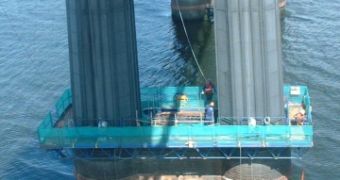Google has applied for a new patent, this time for a water-based data center. The company plans to build several systems more or less at a close distance from the shore, as land is continuously being crowded by huge data centers, which use a lot of conventional energy.
Each center, if approved by the US Patent & Trademark Office, will consist of a plurality of computers contained on a floating platform. The machines will be powered by an electrical generator, and cooled by a cooling unit, all of which will be sea-based.
Google explains that, by gathering the individual centers into a honeycomb-shaped grid, the space necessary for the platform will be incredibly small compared with that required by conventional data centers. Also, the company intends to use wave-motion energy to power the system and also to cool it, so that it can be as self-sufficient as possible.
“In general, computing centers are located on a ship or ships, which are then anchored in a water body from which energy from natural motion of the water may be captured, and turned into electricity and/or pumping power for cooling pumps to carry heat away from computers in the data center. In particular examples, the water-powered devices for generating electricity are depicted as so-called Pelamis machines. The data centers may also be on shore and receive power and/or cooling water from floating systems.” the three inventors explain.
Google assures governmental organization that its data center will interfere as little as possible with other crafts situated in the vicinity of the system. “Motion-powered machines may be used in configurations which accommodate other shipping traffic in the area, such as fishing boats, recreational vessels, shipping vessels, etc. Such traffic may be unduly affected by encounters with the array, such as fishing nets tangled with the tethers. Various signaling mechanisms, such as strobing lights, flags, and horns may be used to alert other ships of the existence and location of a particular field of devices.” says the team applying for the patent.
The entire document is available here.

 14 DAY TRIAL //
14 DAY TRIAL //